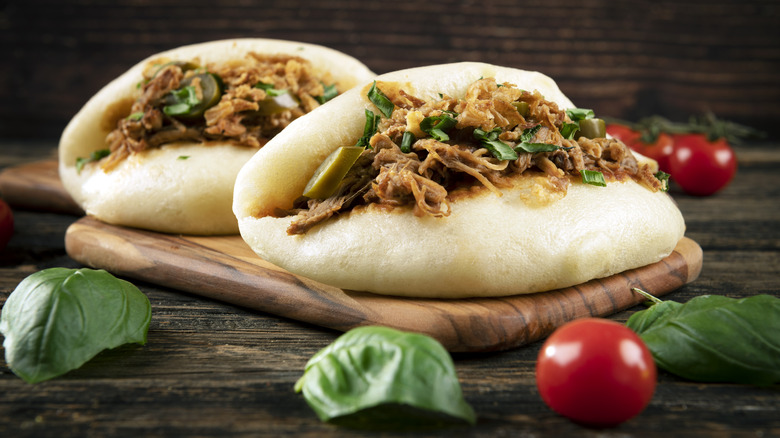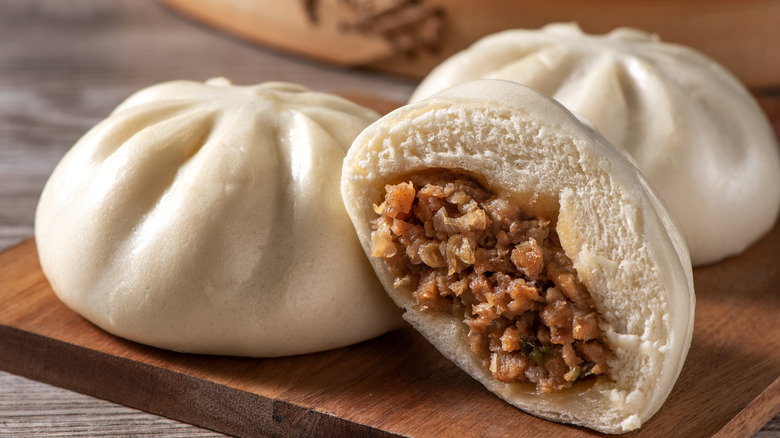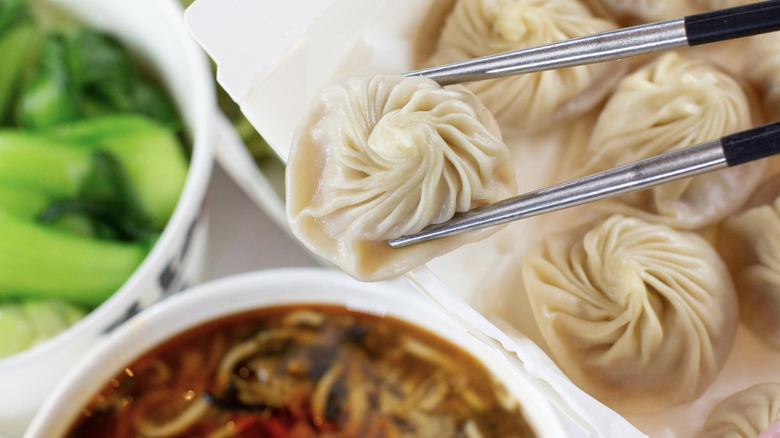What Is A Bao?
The term bao may be unfamiliar in mainstream culinary vocabulary, but it's likely you've encountered this pillowy bun in Chinese and other Asian-style restaurants and markets. It serves as a go-to breakfast treat, street-food meal, an easy lunch or dinner option, and a great crowd pleaser at parties. Bao increasingly appears on fine-dining menus across Asia, Europe, and beyond.
Bao, also known as steamed buns, baozi, or humbow, is basically a soft, fluffy dough that's steamed with various fillings inside. It traditionally presents as a doughy closed bun wrapped around the filling and pinched at the top, but it can also be served open-faced as a "gua boa," which is a flat, lotus-leaf style bun that folds over the filling. This version is a mainstay of Taiwanese street food.
Though often compared to Asian-style dumplings, bao differs significantly in texture and preparation. The addition of yeast to bao dough gives it a more bread-like consistency than dumplings, and it tends to be slightly sweeter, larger, and holds more filling. The rounded bao bun is cooked with steam rather than boiled or pan-fried, resulting in a soft, evenly cooked exterior.
Bao varieties, fillings, and folding techniques
Bao fillings tend to be savory, balancing out the sweetness in bao dough. Pork is one of the most common ingredients resting inside the fluffy buns, sometimes pork belly but more often barbecue-style pork, appearing on menus as cha siu bao. A unique soup-filled version of bao, known as tangbaozi, requires a straw for consuming the broth before enjoying the bun. However, some bao enthusiasts advocate prying the top open and slurping the soup with a ramen-style spoon. Vegetarian versions of bao include doushabao, featuring a bean paste filling crafted from navy, soy, mung, azuki, or similar bean varieties. More bao favorites incorporate sweet custard or a coconut and egg jam.
With bao becoming more mainstream, the dough-forming technique has evolved into a smoother, more accessible form. But making the original, traditional bao involves true culinary artistry with twirling pleats that peak at the pinnacle of the bun. The process involves pulling upwards at the edges of the rounded dough, with the filling in the center, then pleating and folding the dough around the entire circumference. In the grand finale, the edible art gets pinched together at the top before steaming.
Bao origin stories and devotees
Like many food techniques, especially from countries like China with thousands of years of history, the story of bao consists of handed down and only sometimes-recorded knowledge. Some date bao invention to a third-century military strategist in Northern China named Zhuge Liang. The legend involves a river and giant balls of dough shaped like human heads meant to deceive enemy forces.
At one point, bao bore the name mantou, which is still used today in reference to steamed buns without fillings. Stuffing a mantou with savory or sweet meats and vegetables eventually claimed the name bao, a Mandarin-language term meaning "to wrap."
A far more recent bao history revolves around xiaolongbao, often written as xiao long bao, featuring a mixture of meats and a broth resulting from the addition of a jelly-like meat stock known as aspic. One version of the tale conjures images of Mongols traversing the Silk Road with khinkali-style xiaolongbaos in tow, while another credits an enterprising restaurateur from the 1800s. Regardless, the Shanghai government designated these little beauties as protected national treasures in 2006.
In the U.S., xiao long bao holds crave-worthy status for devotees of the ever-expanding Taiwanese restaurant chain, Din Tai Fung. A small army of white-clad masked chefs behind glass windows put on a show of bao creation for the long lines of hungry diners awaiting their turn at the table.



